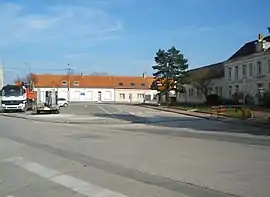Marck
Mark | |
|---|---|
 The centre of Marck | |
 Coat of arms | |
Location of Marck | |
 Marck  Marck | |
| Coordinates: 50°56′55″N 1°57′03″E / 50.9486°N 1.9508°E | |
| Country | France |
| Region | Hauts-de-France |
| Department | Pas-de-Calais |
| Arrondissement | Calais |
| Canton | Marck |
| Intercommunality | CA Grand Calais Terres et Mers |
| Government | |
| • Mayor (2020–2026) | Corinne Noël[1] |
| Area 1 | 31.55 km2 (12.18 sq mi) |
| Population | 10,494 |
| • Density | 330/km2 (860/sq mi) |
| Time zone | UTC+01:00 (CET) |
| • Summer (DST) | UTC+02:00 (CEST) |
| INSEE/Postal code | 62548 /62730 |
| Elevation | 0–14 m (0–46 ft) (avg. 6 m or 20 ft) |
| 1 French Land Register data, which excludes lakes, ponds, glaciers > 1 km2 (0.386 sq mi or 247 acres) and river estuaries. | |
Marck (French pronunciation: [maʁk]; West Flemish: Mark) is a commune in the Pas-de-Calais department in the Hauts-de-France region of France.[3]
Geography
Marck is a farming and light industrial town located 6 km east of Calais, at the junction of the D940 and D248 roads. The A26 autoroute (‘autoroute des Anglais’) passes through the commune and the Louis Blériot airport is in the middle of the commune. The small villages of Les Hemmes-de-Marck and Fort-Vert, both on the D191 road, are included in the population. Calais–Dunkerque Airport is situated in the commune.
Politics
Pierre-Henri Dumont served as the Mayor from 2014 to 2017.[4]
Demographic evolution
| Year | Pop. | ±% p.a. |
|---|---|---|
| 1968 | 4,576 | — |
| 1975 | 5,735 | +3.28% |
| 1982 | 7,448 | +3.80% |
| 1990 | 9,069 | +2.49% |
| 1999 | 8,987 | −0.10% |
| 2007 | 9,123 | +0.19% |
| 2009 | 9,340 | +1.18% |
| 2012 | 10,175 | +2.90% |
| 2014 | 10,676 | +2.43% |
| 2017 | 10,676 | +0.00% |
| 2020 | 10,523 | −0.48% |
| Source: INSEE[5] | ||
The commune has three elementary schools and one middle school.
Main sights
- The church of St. Martin, dating from the twentieth century, is an official historical monument since January 17, 2002. The original church, dated from the 15th century, was destroyed with explosives in 1944 during World War II.[6]
- There is a headstone placed in memory of those who perished during the bombing of Rue Du Sable in Marck on September 28, 1944 by the Allied Forces. This bombing killed over 30 inhabitants and injured many, the largest Marck had ever faced at one time. This street was subsequently renamed Rue du 28 Septembre in memory of this terrible tragedy.[6]
- The brick tower of an old windmill.
- There is a war memorial at the center of the town with the names of town locals that were killed during World War I, World War II and other subsequent wars.
See also
References
- ↑ "Répertoire national des élus: les maires". data.gouv.fr, Plateforme ouverte des données publiques françaises (in French). 2 December 2020.
- ↑ "Populations légales 2021". The National Institute of Statistics and Economic Studies. 28 December 2023.
- ↑ INSEE commune file
- ↑ "Biographie de Pierre-Henri Dumont - Marck-en-Calaisis". www.ville-marck.fr. Retrieved 9 January 2020.
- ↑ Population en historique depuis 1968, INSEE
- 1 2 Littoral, Nord. "Il y a 70 ans, la ville de Marck était martyrisée par une bombe". Nord Littoral. Retrieved 23 October 2016.
Wikimedia Commons has media related to Marck (Pas-de-Calais).
This article is issued from Wikipedia. The text is licensed under Creative Commons - Attribution - Sharealike. Additional terms may apply for the media files.